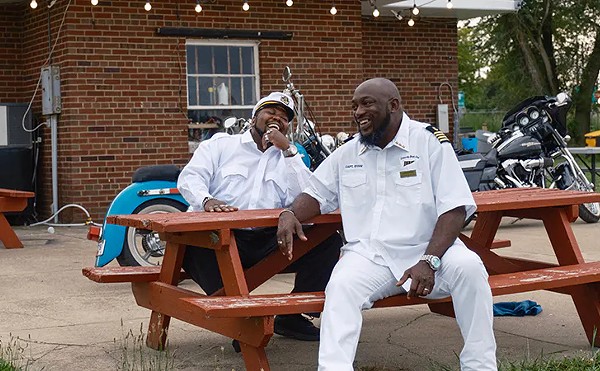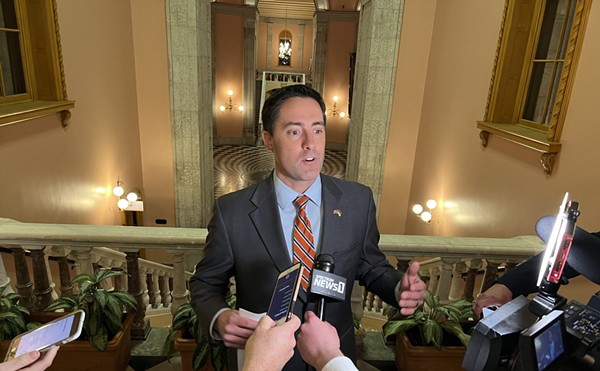"There are always crises," says former board trustee Sue Adams. "There always will be." Asked to list the most vivid among them, she winces. To list them would be to relive them.
In a perfect world, the Mental Health Board would give peace of mind to some 32,000 mentally ill individuals. It doesn't serve them directly; instead, the board pays 36 nonprofit agencies to provide counseling and care.
Perfection has long evaded the board. In fact, to achieve mediocrity would be a great leap forward. Even board leadership acknowledges this.
"We could have a long and interesting conversation about what the flaws are," sighs chairman Mike Thomas.
He concedes the problems start at the top, with his own panel of trustees. There are supposed to be 18 members in the governing body, but there are just 16 today. The most suspense-filled part of board meetings is the beginning, as trustees wait to see whether a quorum will show. At February's meeting, that took an hour. County commissioners are supposed to appoint the members, but they can't even find applicants. After all, there aren't many people clamoring for an unpaid, part-time job trying to cure one of the most chronically mismanaged agencies in the county.
Psychiatrists and caseworkers are just as scarce. They get overworked and jaded; then they get out. And when a caseworker leaves, his or her 60 mentally ill clients are left for months to fend for themselves. Getting prescriptions and time with a counselor becomes a major undertaking, even for patients who talk about suicide.
The board beseeches the county and state for more money, but it hemorrhages the dollars it already has: For half of last year, the board was paying two executive directors, though one was fired nine months ago. This year, it has run up a $500,000 debt for clients housed in state hospitals.
If that weren't enough, some agencies under the board's umbrella keep records with the skill of the Cleveland Finance Department. When they botch Medicaid paperwork, which is often, reimbursements don't come. In some cases, agencies have falsified documents to make up for what they've lost.
The conditions are most wretched on the near East Side, where black consumers grumble about the mostly white board.
"I hate to use the word 'racial,' but when you see money being dispersed on the West Side and agencies closing on the East Side, what does that say?" asks one client.
No one wants to answer questions like that. And no one wants any part of the blame for the pile of rubble that is the Mental Health Board. This is why the county pays an executive director $113,000.
It's a job with no shortage of challenges. But three decades have shown that the executive director is little more than a well-paid whipping boy. Of those who've served, most have resigned in failure. The rest have been fired.
Yet there are 37 intrepid souls applying for the post. Maybe there is a savior among them. Maybe not.
Upheaval at the top is an embarrassment to the board, but it has dire consequences for the mentally ill. When they need help, they can't count on it.
A well-managed mental health system probably wouldn't have left Margaret Bolling alone in her Collinwood home, with her candles, cats, and dogs.
A board agency had assigned a caseworker to her; yet Bolling, who suffered from clinical depression and bipolar disorder, was allowed to live alone in a home with no heat or electricity. In January, a candle tipped over, setting Bolling's house ablaze. She perished in the fire.
No one was watching Alvintino Hogan of Euclid when he stopped taking his medication. It's thought to be the reason that, last October, he whipped out a gun on an RTA bus and shot 38-year-old Dawne Guyon in the head. He didn't know her.
Mental health boards inherit the most severe cases of mental illness, and predicting a client's next move can get dicey. The difficulty is compounded by the dozens of clients assigned to each caseworker and the shortage of psychiatrists, facilities, and services.
Such challenges apply to mental health systems nationwide, leading most to prioritize clients who are on the brink of rash action. Cuyahoga County's system often lacks such prioritization.
A former caseworker on the East Side remembers being scolded by supervisors for counseling suicidal clients. Without a license, he was allowed only to place them on a waiting list for time with a psychiatrist; he worried that one day, he'd wake up to a dead client.
Other caseworkers simply become numb to their clients' needs. Al, a West Side man with schizophrenia, recalls his caseworker showing up once every few weeks, only to have him sign a form saying she was providing services for him. "She wasn't doing anything for me," he says, so he told her to stop coming. Al hasn't seen her -- or any caseworker -- for eight months.
A woman with bipolar disorder didn't trust her agency to provide medication in a timely manner, so she befriended an orderly at a nursing home who salvaged pills from the trash for her.
When the orderly switched jobs, the woman's supply dwindled. Her caseworker had resigned -- and a replacement had not been hired -- so she called the Mental Health Board directly to ask how to get pills to prevent a breakdown.
"There are lots of people with that problem," she was told. The staff member didn't offer advice about how to solve it.
Without medication, the woman became manic. She hardly slept or ate. When she had a breakdown in public, the police handcuffed her, tossed her in a cruiser, and took her to a hospital. It was the first time in 20 years that she had been institutionalized.
"Here I was, trying to avert this exact situation," she says. "I hated being in the hospital. I didn't need to be there. If I had just got my medication, it could have all been prevented."
She finally got a caseworker, when she left the hospital nearly a year ago. Before Christmas, that caseworker resigned. Today, the woman with bipolar still hasn't been assigned someone new.
Agency directors say personal tales like these are rarely as one-sided as they sound, that often the client's own irresponsibility is glossed over. But confidentiality forbids agencies and the board from discussing specifics of a client's case.
Still, the sheer number of clients per caseworker means there are gaping cracks through which the mentally ill can slip.
When Ella Thomas became the Mental Health Board's deputy director in late 1993, it was like becoming vice president in a banana republic with a history of assassinations.
At that time, Phillip E. Dukes was taking his turn between the crosshairs.
A native Clevelander, Dukes was hired as executive director after a nationwide search. He was chosen in part for his success at a giant mental health facility in Detroit -- a facility that would later prove to be far smaller than Dukes had claimed. That wasn't the only unpleasant surprise. Board trustees soon learned that Dukes's business car would have to be purchased from his old agency (which still held the lease), that he favored dining at pricey restaurants at the board's expense, and that his surly and uncompromising temperament alienated staff.
The trustees had misjudged Dukes and wanted him out. Dukes responded by dismissing board staff members he thought were aligned with trustees. In April 1994, after 15 embattled months, he was fired.
It was not a quiet departure. Dukes, who is black, sued the board for discrimination, accusing trustees of firing him in retaliation for his dismissal of white employees. The case drained the board budget for five years before it was finally settled -- with a $50,000 check to Dukes. (Dukes did not return phone calls for this story.)
Ella Thomas seemed the perfect antidote. She was effusive, with a wide smile and a dignified air. It didn't hurt that, as a black woman, she could dispel Dukes's claims of board prejudice.
Her enthusiasm lifted workers. If staff groused over board policies, Thomas asked them what they would change. Formerly isolated workers began solving problems as teams. For the first time, they had input on how the board spent its money. It was all part of Thomas's plan to smoke out cynicism.
"A lot of the staff had said, 'This has gone on for years. Nobody's done anything with this agency,'" Thomas recalls. "I wanted to build the trust and confidence of the staff."
Thomas's days began at 8 a.m. and usually ended after 8 p.m. She attended meetings on weekends. Her employees became infected by her work ethic, but she was not the type to badger them into longer hours.
"She's not rough," says Dr. Howard Hall, a psychologist active with the board during Thomas's early years. "I never heard her yell or swear at a meeting -- and I can't say that about any of the past executive directors."
But Thomas's placid demeanor belied the constant state of chaos within the board, much of which she inherited from directors past.
Dukes had woefully underestimated "bed days," the number of clients who would require treatment in state hospitals. The board was funded for a certain number of bed days and had to pay the state for each one it used beyond its allowance. That debt was $2.6 million.
Dukes's mistake was Thomas's problem. Frantically, she mailed applications for state grants. She scooped up dollars not already committed to other programs. In the end, she had just enough to keep from cutting services.
Yet Thomas wanted the board to do more than simply survive from crisis to crisis. So she set out to make corrections at the very roots of the system's flaws.
She tightened the monitoring of hospital stays and gave three agencies sole responsibility for unloading patients who were able to live independently. She says the board paid for 120,000 bed days the year before her policy change. It dropped to 48,000 after the change, freeing the board from its annual scramble to escape its debts to the state.
Not every problem could be so easily remedied. Thomas heard that some agencies did a haphazard job of documenting their services. Errant documentation meant that federal Medicaid dollars were held back. A look at the books confirmed her suspicions.
"People were billing for things that they probably weren't supposed to," says Thomas. "They might not have provided the service, or they might not have billed for the service in the correct way. It could be the number of hours was incorrect. It could be the signatures weren't there. There were whole programs that they were billing wrong."
To this day, no one knows how much money was lost or gained through flawed and fraudulent billing.
In the past, the board had always bailed mismanaged agencies out of their debts. To let them collapse would have left clients with nowhere to go.
And auditing the agencies that spent board money would only publicize their ineptitude. The two executive directors who preceded Thomas didn't dare conduct audits.
Thomas, however, vowed to audit every agency once a year. If the board found faulty bookkeeping or waste, the agencies would have their funding yanked.
Community Guidance Incorporated, known as CGI, emerged as the worst offender. The agency, which served 2,000 clients, was a sacred cow by virtue of its size. If its service was spotty, its leadership unresponsive, it remained one of the few places to turn for the near East Side's mentally ill.
Thomas's auditors reported to the board that CGI's billing was random and ravaged by mistakes. This was causing it to lose its Medicaid reimbursements.
At a January 1997 board meeting, Thomas moved to cut off CGI's funds -- a certain death blow to the agency. Politicians and neighborhood activists condemned Thomas and board trustees. The contract was terminated anyway. CGI closed its doors.
"It was the first time the board had ever taken on anything like that," says Thomas. "You're talking about a couple thousand clients. You had no idea how you were going to make that work."
Today, she considers it a "good, calculated risk." And even some who were infuriated by the CGI episode admit that, in retrospect, it was a wise move -- clients were simply being ignored by the agency.
Thomas was pleased by the effect CGI's closure had on other agencies, which had mismanaged themselves with similar impunity.
"CGI was a message to the rest of the system," she says. "Other agencies said, 'We better work on this.'"
The Northeast Community Mental Health Center and the Murtis H. Taylor Multi-Service Center were the only two big urban agencies left on the East Side, and both were money pits in CGI fashion. Thomas hounded them with audits. Northeast, which served 1,000 clients, finally closed in June 2000 amid allegations that its management wasn't just inept but corrupt. Murtis Taylor remains open, sweating through audits.
"Under Ella, agencies really needed to comply with the regulations, and I think that goes down as one of her great legacies," says Steve Friedman, director of Mental Health Services, an agency funded by the board. "She held agencies accountable, and they knew that, if they weren't, these were the consequences."
The enforcer of the bottom line was Karen Rogers, whom Thomas had hired as chief administrative officer. Rogers (she used that name professionally, though her actual last name was Spencer) was not shy in her dealings with agencies. "She would argue with them and get agencies on their tiptoes," says Thomas. "But it was very controversial."
"Controversial" is probably an understatement.
Others employ more vivid terms. "It was mean-spirited and punitive," says Ralph Fee of Bridgeway, one of the largest board-funded agencies.
"It was all about money," says another insider. "The clinical people were pushed aside. Ella was not attending to their advice or their needs."
Thomas talked about improving care to the mentally ill, but since she didn't give the agencies more money to do so, providers felt powerless. Frustrated, they began to suspect her interest in improving service was purely rhetorical -- that all she and Rogers really cared about was the board's financial ledger.
This sentiment spread. Devoted caseworkers tired of the penny-pinching, and they left. Some board staff also perceived Thomas's efforts to be extreme, and they trickled out.
As her rapport with agencies eroded, it didn't help that, when a mentally ill client phoned the board to complain about his service, Thomas encouraged him to attend the monthly board meeting to rage against that agency on the public record. Bound by confidentiality, the agency could not even defend itself.
Tension thickened after Janice Nedin, hired in 1998 to be the board's chief of programming services, issued a stinging evaluation of a black staff member. Thomas charged that Nedin's evaluation was tinged by prejudice, and the evaluation was revised, with Nedin's words omitted. Nedin complained. Thomas fired her.
Nedin, who is white, launched a lawsuit in April 1999, naming Thomas and every board trustee as defendants. In it, Nedin claims that Thomas, Rogers, and the human resources director -- all African Americans -- ganged up on her because she gave a black employee a bad review. The case is still in litigation.
Whatever turbulence shook the board, the panel of trustees had always taken comfort in Ella Thomas's calm manner. She had problems under control.
But by 1999, agency leaders and board staff were bringing complaints about Thomas directly to the trustees. The reports from the front lines of mental health service differed drastically from the picture Thomas presented to trustees in board meetings.
Some, including panel chairman Mike Thomas, began to suspect that Ella Thomas's coolness under pressure was a façade.
"There's a filter that goes on between the executive director and [the trustees]," says Mike Thomas, who's not related to Ella. "The executive director doesn't want to talk about the failures, but only about the successes. That trust was something that eroded over time."
This erosion coincided with a string of crises, the first of which was known as the "Medicaid match."
The board had an obligation to match the federal funds spent on clients who were Medicaid eligible. In 1999, that demand was steeper than anticipated, and the board spent $8.1 million more in Medicaid matching funds than budgeted. Services for clients not Medicaid eligible had to be cut to pay the difference.
Board bookkeepers predicted that the cost of matching Medicaid dollars would grow each year, and that the next year would require more cuts in non-Medicaid services to balance the budget.
The problem deserved Thomas's full attention, but she was distracted by other crises.
When Northeast Community shut down in June 2000, it left 1,000 clients adrift on the already strained East Side. Murtis Taylor, the last big agency serving the inner city, seemed ready to collapse at any minute.
In September 2000, Karen Rogers was found dead in the trunk of her car. She had been in an abusive relationship, and live-in boyfriend Curtis Middleton would be convicted for her murder.
Thomas hardly had time to mourn her friend. Her career was in peril.
The trustees could see that Thomas had lost the support of agencies, that she was slipping in her esteem with board staff, and that for all her hard work, the mental health system was in as much chaos as ever.
The immediate need was to convince state legislators to provide funds to alleviate the Medicaid problem; Thomas seemed ill fit for the task. In their November 2000 evaluation, the trustees found that Thomas "has had a tendency to be overly passive with the state," and that she "has not developed nor implemented plans to increase additional revenue."
Thomas went on the defensive, calling the evaluation "highly subjective and therefore unacceptable." She demanded the trustees retract it. If not, she asked that they explain the proper way to run a giant mental health system on a shoestring budget with an overworked staff and a recalcitrant network of agencies -- all the while serving the infinitely complex needs of the county's mentally ill.
The trustees were unmoved.
"The way we looked at it, if you know you're headed toward a cliff, you better do what you can to turn away from it in time," says Mike Thomas.
At the same time, Ella Thomas's frustration was evident. She was eerily silent at board meetings. Board trustees thought her cool and aloof. And even as Thomas sensed her fate, she behaved with a recklessness that, until then, was out of character.
In April 2001, the board received $61,000 back from the state retirement system. It was money that the board had saved after the premiums for the employees' pension funds dipped. Because the savings were not part of the budget, the board was free to spend the money as it pleased.
Most government agencies applied it to their budgets anyway. Ella Thomas doled it out to board staff, reserving $2,480 for herself.
It was not illegal. A few agencies, like the Alcohol and Drug Addiction Services Board, did the same. But Thomas never cleared it with the Mental Health Board trustees.
Her clash with the trustees played out on the front page of The Plain Dealer. If it looked as though the executive director was cavalier with $61,000, it would not reflect well the next time the board begged politicians for emergency funds.
"It was troubling on several different levels," says Mike Thomas.
On June 27, 2001, Ella Thomas became the latest Mental Health Board executive director to get the boot.
Nine months removed from that day, Ella Thomas has recovered her quick broad grin. She's circulating a new résumé. And she can now ponder her undoing at the Mental Health Board from a distance.
In some ways, she says, she was a victim of her own successes. The hard line with agencies forced them to improve, but it cost her popularity.
"I believe the Mental Health Board has a business responsibility to hold people accountable," says Thomas. "And I can't hold you accountable and be your buddy at the same time."
Terms of Thomas's departure forbid her from uttering opinions on trustees. But she can address the scandal over the disbursement of the pension funds, pointing out that other agency directors also paid staff with the money and were not punished. Besides, she had checked with the county prosecutor's office before she did it. She was told the decision was hers to make.
"I don't regret it, because I don't think I did anything wrong," she says. "The money was not money that would have gone directly to the board. We could have done that, but it wasn't necessarily earmarked for it. It was not a lot of money, when you look at it in terms of whether to give back or not to give back."
Not everyone was outraged by the pension fund disbursement. To its beneficiaries -- the board staff members -- it seemed a fitting reward for their long hours. Some among the mentally ill just shrugged it off. They liked Thomas's tough stance with the agencies and her willingness to listen to their troubles.
This loyal core became Thomas's cheering section at the June meeting where her fate was to be decided. Board clients and staff harangued trustees so fiercely that sheriff's deputies were called into the room. Even then, one trustee claimed a Thomas supporter threatened to shoot him.
It's been nine months, but the rancor is still festering. After Ella Thomas's dismissal, a secret society called the Committee for the Removal of Mike Thomas was born -- ostensibly to circulate hit mailers. In them, board chairman Thomas is cast as a political screw-up who orchestrated the firing to enhance his own power.
Others aren't quite so dramatic in their claims.
Dr. Howard Hall, the psychologist formerly active with the board, believes Mike Thomas could find no legitimate faults with Ella Thomas, and that the firing was purely the result of "a personality conflict."
Hall says he was shocked, then suspicious, after he heard board trustees cite Thomas's "abrasive" management style.
"I find that an offensive description," he says. "An African American woman who speaks her mind: Does that make her abrasive?"
If Ella Thomas dared to make unpopular decisions to improve mental health, it only made her a scapegoat for the trustees, says Clemente Powell, a client who operates TLC, a small East Side agency. "Ella was used to do their dirty work. And after Ella was used, they threw her out."
Powell has long suspected that the board trustees allow race to affect their decisions. He points out that, while CGI and Northeast have closed, the trustees have shown no interest in building a new facility in the largely black neighborhoods those agencies served. He's angry that Northcoast Behavioral Healthcare, which functions as the East Side crisis center, is actually on the near West Side.
Ella Patterson, a black woman who is both a board trustee and a mental health consumer, is noncommittal over whether race played a role in the trustees' decision to fire Thomas. Patterson was one of just three board members to vote against the dismissal.
She frets more over what she perceives as the power play of the board. "They want someone they can control," she says, "and they didn't have that with Ella."
Mike Thomas, who spends 60 to 80 hours a month tending to board governance, wearily denies that control issues, race, or personality had anything to do with Ella Thomas's firing.
"Ella Thomas is one of the nicest people you'll ever meet," he says. "She's the perfect next-door neighbor." She just wasn't perfect for this county's mental health system.
Ella Thomas may be out, but the board's ever-present stench of failure remains.
The year began with Margaret Bolling perishing in the fire and the subsequent bad press that tragedy incurred. Also in January, the board learned that the controller of Beech Brook, a contracted agency, had absconded with $7,000 on an agency credit card. And the bed-days debt looms as the largest in the Mental Health Board's history. Paying it back may force the board to trim services.
A return of the bed-days debt, agency management stealing money, clients dying -- the Ella Thomas firing was supposed to improve the board and impress those who determine its budget. So far, it hasn't.
In December, Cuyahoga County commissioners laughed off a board suggestion to place a levy on the ballot that would authorize new funds to see the board through its most recent fiscal crisis.
"You have to have credibility to get that sort of levy adopted," says Commissioner Tim McCormack. "And we're far from the point where we'd recommend to this community that this system gets more public money."
It didn't help that, while the board was warning that budget cuts would result in loss of service for thousands of mentally ill clients, it was paying for two executive directors: Ella Thomas, who was placed on administrative leave while she and the board negotiated a parting, and Valeria Harper-Bledsoe, the interim leader.
County officials have tired of mental health emergencies. Seeking a longer-term remedy, the commissioners gave the Federation for Community Planning two years to study the board. At the same time, state regulators will conduct a $400,000 performance audit to see how the board is spending its money.
Commissioners have begun uttering the word "reorganization." McCormack wants to start at the top, with trustees.
"They have an 18-member governing board," he says. "Who do you hold accountable?" He would pare the number down to five.
This would at least ensure that all the chairs on the panel are filled. But even then, it might be difficult to attract qualified trustees. As political appointments go, the Mental Health Board is a veritable curse.
"These are people with other responsibilities in their lives," points out Miriam Plax, executive director of the National Alliance for the Mentally Ill. "They don't sit around waiting to go to Mental Health Board meetings."
Early in January, Ella Thomas's administrative leave was terminated and her dismissal finalized. Since then, trustees have been searching for the next leader, now called chief executive officer, not executive director.
Acting CEO Valeria Harper-Bledsoe did not submit an application. Bridgeway's Ralph Fee, who finished second to Phillip Dukes nearly a decade ago, doesn't want the job either. Steve Friedman of Mental Health Services has applied, but former Children & Family Services Director Bill Denihan is said to be the favored candidate of Mike Thomas.
As ever, the new leader of the board will need to deliver fresh optimism and relish the challenge of remodeling one of the most woebegone agencies in Cleveland. In short, it's going to take a miracle worker.
"They're not going to do it overnight," says Plax. "They'll have to look for new resources. The system lost $2 million in revenue last year, so there are budget cuts to be made. Whoever takes that job will walk into an office in crisis mode."
It won't be the first time.











